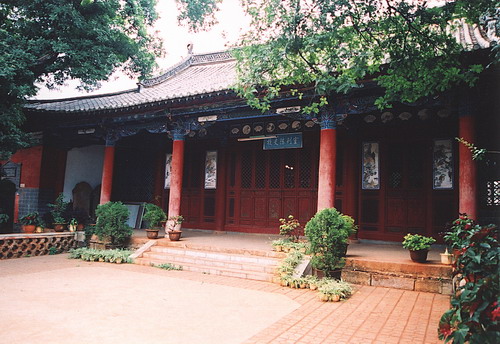
Former Residence of Xiong Qinglai in Mile City, Honghe
Overview
The Former Residence of Xiong Qinglai (熊庆来故居, Xióng Qìnglái Gùjū) is an important historical site located in Qinglei Village, Pengpu Town, Mile City (弥勒市, Mílè Shì), Honghe Hani and Yi Autonomous Prefecture (红河哈尼族彝族自治州, Hónghé Hānizú Yízú Zìzhìzhōu), Yunnan Province (云南省, Yúnnán Shěng). Established during the Qing Dynasty under Emperor Guangxu (光绪, Guāngxù) between 1875 and 1908, it spans 1,055 square meters.
This residence is significant not only for its architectural style but also as a testament to the life and achievements of Xiong Qinglai, a notable figure in modern Chinese science and education. It stands as a patriotic education site that showcases his scientific legacy and contributions to mathematics.
On March 5, 2013, it was recognized as a national key cultural relic protection unit by the State Council of the People’s Republic of China.
Key Information
- Chinese Name: 熊庆来故居
- Location: Qinglei Village, Pengpu Town, Mile City, Honghe Hani and Yi Autonomous Prefecture, Yunnan Province
- Period: 1893
- Area: 1,055 m²
- Protection Level: National Key Cultural Relic Protection Unit (7th batch)
- Approval Authority: State Council of the People’s Republic of China
Historical Development
The residence was constructed by Xiong Qinglai’s father, Xiong Guodong (熊国栋, Xióng Guódòng), during the Guangxu period. In 1999, it was designated as a provincial patriotic education base by the Yunnan Provincial Committee of the Communist Party of China and the provincial government.
Key milestones in the residence’s history include:
- 2014: The Yunnan Provincial Institute of Cultural Relics and Archaeology conducted field surveys and measurements, leading to a design plan approved by the National Cultural Heritage Administration.
- 2019: Funding was allocated for fire safety system improvements.
- 2022: The fire safety system was completed and passed inspection, ensuring the preservation of this important cultural site.
Architectural Layout
The residence’s layout reflects traditional southern Yunnan architectural styles, primarily a quadrangular courtyard layout known as a “siheyuan” (四合院). It consists of:
- Main Entrance: A grand entrance with intricate wood carvings and a plaque inscribed by renowned calligrapher Chu Tunan (楚图南, Chǔ Túnán), stating “Former Residence of Xiong Qinglai.”
- Main House: Features a double-eaved gable roof structure measuring 12 meters in width and 10.5 meters in depth, with a total height of 8.5 meters. Inside, it houses a collection of Xiong Qinglai’s works, documents, and personal items.
- Side Rooms (耳房, ěr fáng): These are used for additional living spaces. The southern side room was originally a study, while the northern one is adjacent to the ancestral hall. Notable calligraphy by Xiong Guodong adorns the walls.
- Living Room (客厅, kètīng): A simpler design, this area has a single-eaved roof and measures 6.4 meters wide and 5 meters deep, serving as a gathering space for family and guests.
- Inner Courtyard: The inner courtyard features two spacious areas, including an impressive bronze statue of Xiong Qinglai.
- Longevity Hall (寿堂, shòutáng): Located north of the kitchen, this hall is a prominent feature of the residence, characterized by a heavy-eaved roof.
- Ancestral Hall (祠堂, cítáng): Situated in front of the Longevity Hall, this single-eaved structure measures 14 meters wide and 7.1 meters deep. It displays an exhibition of Xiong Qinglai’s life, including photographs and a bust made of fiberglass.
Cultural Significance
Xiong Qinglai (熊庆来, Xióng Qìnglái, 1893–1969) was a pioneer in modern science and higher mathematics education in China. He studied at various institutions, including the Yunnan Higher School and later abroad, obtaining a master’s degree in science. Upon his return, he taught at several prestigious universities, including Southeast University and Tsinghua University.
His notable contributions include:
- Research in Complex Functions: Xiong conducted significant research in this area, leading to a well-regarded doctoral thesis titled “The Theory of Infinite Series of Meromorphic Functions,” known internationally as the “Xiong’s Infinite Series.”
- Educational Influence: Xiong was a mentor to many prominent mathematicians, including Hua Luogeng (华罗庚, Huá Luógēng) and Hu Kunsheng (胡坤升, Hú Kūnshēng).
In memory of Xiong Qinglai, local communities have named parks, roads, and schools after him, and his hometown was renamed Qinglei Village, reflecting his enduring legacy.
Travel Information
How to Get There
By Car: The residence is approximately 50.3 kilometers from the Mile City Government, taking about one hour by car.
Public Transport: Check local bus schedules for routes to Mile City and then take a taxi to Qinglei Village.
Travel Tips
- Best Time to Visit: Spring (March to May) and autumn (September to November) are ideal for pleasant weather and beautiful scenery.
- Local Cuisine: Don’t miss trying traditional Yunnan dishes, such as “crossing the bridge rice noodles” (过桥米线, Guòqiáo Mǐxiàn) and local mushrooms.
- Cultural Respect: Be mindful of local customs and traditions, especially when visiting historical sites.
- Photography: Capture the unique architecture and natural beauty, but be respectful of areas where photography might be restricted.
- Guided Tours: Consider hiring a local guide to enhance your understanding of the historical significance and cultural context of the site.

Location:

 7 Days GolfingTour
7 Days GolfingTour
 8 Days Group Tour
8 Days Group Tour
 8 Days Yunnan Tour
8 Days Yunnan Tour
 7 Days Shangri La Hiking
7 Days Shangri La Hiking
 11 Days Yunnan Tour
11 Days Yunnan Tour
 6 Days Yuanyang Terraces
6 Days Yuanyang Terraces
 11 Days Yunnan Tour
11 Days Yunnan Tour
 8 Days South Yunnan
8 Days South Yunnan
 7 Days Tea Tour
7 Days Tea Tour
 8 Days Muslim Tour
8 Days Muslim Tour
 12 Days Self-Driving
12 Days Self-Driving
 4 Days Haba Climbing
4 Days Haba Climbing
 Tiger Leaping Gorge
Tiger Leaping Gorge
 Stone Forest
Stone Forest
 Yunnan-Tibet
Yunnan-Tibet
 Hani Rice Terraces
Hani Rice Terraces
 Kunming
Kunming
 Lijiang
Lijiang
 Shangri-la
Shangri-la
 Dali
Dali
 XishuangBanna
XishuangBanna
 Honghe
Honghe
 Kunming
Kunming
 Lijiang
Lijiang
 Shangri-la
Shangri-la
 Yuanyang Rice Terraces
Yuanyang Rice Terraces
 Nujiang
Nujiang
 XishuangBanna
XishuangBanna
 Spring City Golf
Spring City Golf
 Snow Mountain Golf
Snow Mountain Golf
 Stone Mountain Golf
Stone Mountain Golf

















